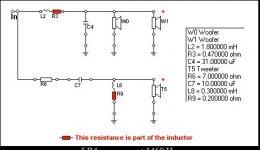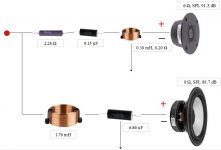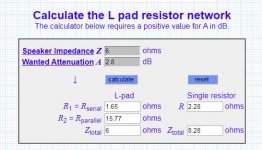Hi All,
I have these drivers on hand and wanted to try using them together in a sealed 2-way. Also on hand are PE 0.38 cu.ft. cabs.
The 8" Daytons seem to have similar FR to the 7"s, and John Krutke paired the 7s with the H1212 in his BAMTM design, with 4th order electrical slopes on both sides, XO at 1,450 Hz. So I'm wondering if a quick and dirty way would be to use the same (or very similar) crossover with mine.
I am definitely on a budget and have little time to do a full-blown, down-to-the-last-detail design (I'm unable to use any XO software because my free spreadsheet software isn't fully compatible), hence wanting to use on-hand drivers, etc., and just achieve a listenable design, if possible.
So, do you feel these drivers are reasonably compatible, and how adapatable, if at all, is the BAMTM XO for it? If it should be modified I'd appreciate thoughts on that.
Sorry but my resources and technical skills are still limited (after all these years), so I'm still climbing the learning curve.
Thanks for your help!
I have these drivers on hand and wanted to try using them together in a sealed 2-way. Also on hand are PE 0.38 cu.ft. cabs.
The 8" Daytons seem to have similar FR to the 7"s, and John Krutke paired the 7s with the H1212 in his BAMTM design, with 4th order electrical slopes on both sides, XO at 1,450 Hz. So I'm wondering if a quick and dirty way would be to use the same (or very similar) crossover with mine.
I am definitely on a budget and have little time to do a full-blown, down-to-the-last-detail design (I'm unable to use any XO software because my free spreadsheet software isn't fully compatible), hence wanting to use on-hand drivers, etc., and just achieve a listenable design, if possible.
So, do you feel these drivers are reasonably compatible, and how adapatable, if at all, is the BAMTM XO for it? If it should be modified I'd appreciate thoughts on that.
Sorry but my resources and technical skills are still limited (after all these years), so I'm still climbing the learning curve.
Thanks for your help!
Attachments
since you have the drivers on hand, you have nothing to lose really.
If you only want to simulate - you could use manufacturer data with your intended baffle step and diffraction response applied to get an on-axis curve in the ballpark and see if you have any low impedance risks.
XSim (free?) and VituixCAD (definitely free) are both excellent. VituixCAD only took a few hours for me to get to grips with and I ain't smart 🙂
The above won't prove off-axis behaviour - especially vertical, but get you a ballpark crossover.
My concern with the 27tbfcg is you'll need to go at least 4th order electrical to provide enough protection (or even eliptical). I think the tweeter will stress before the woofers.... meaning failure may not come with much or any warning. It all depends on what level these will be demanded to play of course.
The 8" drivers have their primary breakup ~ 6Khz. I'd expect 3rd order HD to peak around 2000Hz - so you might find these are shouty. A 1.45KHz crossover may not be low enough to avoid the distortion... but you won't know until you try.
If you only want to simulate - you could use manufacturer data with your intended baffle step and diffraction response applied to get an on-axis curve in the ballpark and see if you have any low impedance risks.
XSim (free?) and VituixCAD (definitely free) are both excellent. VituixCAD only took a few hours for me to get to grips with and I ain't smart 🙂
The above won't prove off-axis behaviour - especially vertical, but get you a ballpark crossover.
My concern with the 27tbfcg is you'll need to go at least 4th order electrical to provide enough protection (or even eliptical). I think the tweeter will stress before the woofers.... meaning failure may not come with much or any warning. It all depends on what level these will be demanded to play of course.
The 8" drivers have their primary breakup ~ 6Khz. I'd expect 3rd order HD to peak around 2000Hz - so you might find these are shouty. A 1.45KHz crossover may not be low enough to avoid the distortion... but you won't know until you try.
I recommend that you go to PE Tech Talk and ask for help. They are usually a friendly and helpful group.
Thank you Dave!
I have both XSim and Vituix, but my spreadsheet software isn't compatible with them - it says after downloads and opening that not all components were downloaded - when i try to use them they just kind of sit there.
But your advice is well taken - I thought a lower XO point would probably be a good idea, and I'll take a look at a 4th order electrical filter for the tweeter - these things might just keep the drivers happy.
I have both XSim and Vituix, but my spreadsheet software isn't compatible with them - it says after downloads and opening that not all components were downloaded - when i try to use them they just kind of sit there.
But your advice is well taken - I thought a lower XO point would probably be a good idea, and I'll take a look at a 4th order electrical filter for the tweeter - these things might just keep the drivers happy.
I recommend that you go to PE Tech Talk and ask for help. They are usually a friendly and helpful group.
Thanks Speakerman! Great idea - i'll give that a shot.
Thank you Dave!
I have both XSim and Vituix, but my spreadsheet software isn't compatible with them - it says after downloads and opening that not all components were downloaded - when i try to use them they just kind of sit there.
But your advice is well taken - I thought a lower XO point would probably be a good idea, and I'll take a look at a 4th order electrical filter for the tweeter - these things might just keep the drivers happy.
when you say your spreadsheet software isn't compatible....
What format data are you exporting? FRD/ZMA are nothing more than space or tab delimited text files. As long as you don't have a header row and you have all 3 "fields" - you should be fine to import. I dont' think the files have to be data point matched on frequency across the drivers... although I do re-sample my files before importing.
Yes the tech talk parts express forum is a good suggestion. Parts express also have a project "showcase" so you may be able to search on driver model numbers and find a design.
When switching to and from XSim/VCad/Excel I have endless problems with dot or comma decimal point separator. But since frd/zma are text files, a replace all in notepad fix the problem.
Ralf
Ralf
This is what John Krutke said about his BAMTM design:
"Some listening tests at higher levels were required to make sure the tweeter was not under strain at this crossover point, and it passed with flying colors. In all cases, the woofers gave out first, either by exceeding Xmax in the low bass or by compressing the midbass and midrange. LR4 offers the highest power handling possible for a tweeter for a given crossover point. It almost seems counter intuitive that LR4 handles more power than LR6 or LR8, but that fact is that peak excursion happens above the crossover point for these filters, and LR4 starts it's rolloff much sooner than LR6 or LR8. As a result, the steeper slopes require a tweeter to have comparatively more ouput just above the crossover point. This can be simulated with excursion modeling, provided T/S parameters can be obtained for the tweeter. Remember that LR4 will always be your best option if you want the most power handling out of your tweeter."
So if he was able to reach 4th order acoustic with only 2 components, I'd simply leave this part of the crossover unchanged, apart the resistor used to pad down the response, as the 2x parallel DA175 have more output than a single DA215. You have to redesign the LP filter, as it is designed for a completely different impedance.
Ralf
"Some listening tests at higher levels were required to make sure the tweeter was not under strain at this crossover point, and it passed with flying colors. In all cases, the woofers gave out first, either by exceeding Xmax in the low bass or by compressing the midbass and midrange. LR4 offers the highest power handling possible for a tweeter for a given crossover point. It almost seems counter intuitive that LR4 handles more power than LR6 or LR8, but that fact is that peak excursion happens above the crossover point for these filters, and LR4 starts it's rolloff much sooner than LR6 or LR8. As a result, the steeper slopes require a tweeter to have comparatively more ouput just above the crossover point. This can be simulated with excursion modeling, provided T/S parameters can be obtained for the tweeter. Remember that LR4 will always be your best option if you want the most power handling out of your tweeter."
So if he was able to reach 4th order acoustic with only 2 components, I'd simply leave this part of the crossover unchanged, apart the resistor used to pad down the response, as the 2x parallel DA175 have more output than a single DA215. You have to redesign the LP filter, as it is designed for a completely different impedance.
Ralf
When switching to and from XSim/VCad/Excel I have endless problems with dot or comma decimal point separator. But since frd/zma are text files, a replace all in notepad fix the problem.
Ralf
Yes Ralf thank you.
This is what John Krutke said about his BAMTM design:
"Some listening tests at higher levels were required to make sure the tweeter was not under strain at this crossover point, and it passed with flying colors. In all cases, the woofers gave out first, either by exceeding Xmax in the low bass or by compressing the midbass and midrange. LR4 offers the highest power handling possible for a tweeter for a given crossover point. It almost seems counter intuitive that LR4 handles more power than LR6 or LR8, but that fact is that peak excursion happens above the crossover point for these filters, and LR4 starts it's rolloff much sooner than LR6 or LR8. As a result, the steeper slopes require a tweeter to have comparatively more ouput just above the crossover point. This can be simulated with excursion modeling, provided T/S parameters can be obtained for the tweeter. Remember that LR4 will always be your best option if you want the most power handling out of your tweeter."
So if he was able to reach 4th order acoustic with only 2 components, I'd simply leave this part of the crossover unchanged, apart the resistor used to pad down the response, as the 2x parallel DA175 have more output than a single DA215. You have to redesign the LP filter, as it is designed for a completely different impedance.
Ralf
Thank you very much Ralf - I had completely forgot about the difference in impedance; I will re-do the LP filter for 8 ohm and also adjust tweeter padding.
Here is what I've crudely done to this point, recalculating the LP filter for an 8 ohm woofer (XO point 1,450 hZ). I also changed the padding on the tweeter according to the calculation shown in the attached image, but I don't know if I have translated it correctly. I believe the resistance in the HP inductor can be used as part of an L-Pad, but I don't know if that means the resistor value should be changed as the attenuation was calculated for a single resistor.
Attachments
- Home
- Loudspeakers
- Multi-Way
- 2-Way With Dayton DA215-8 + SEAS H1212?


